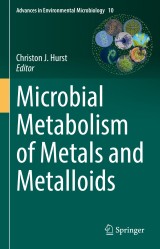Details

Microbial Metabolism of Metals and Metalloids
Advances in Environmental Microbiology, Band 10
|
181,89 € |
|
| Verlag: | Springer |
| Format: | |
| Veröffentl.: | 24.04.2022 |
| ISBN/EAN: | 9783030971854 |
| Sprache: | englisch |
| Anzahl Seiten: | 660 |
Dieses eBook enthält ein Wasserzeichen.
Beschreibungen
<p>This book explains the metabolic processes by which microbes obtain and control the intracellular availability of their required metal and metalloid ions. The book also describes how intracellular concentrations of unwanted metal and metalloid ions successfully are limited. Its authors additionally provide information about the ways that microbes derive metabolic energy by changing the charge states of metal and metalloid ions.</p><p>Part one of this book provides an introduction to microbes, metals and metalloids. It also helps our readers to understand the chemical constraints for transition metal cation allocation.</p><p>Part two explains the basic processes which microbes use for metal transport. That section also explains the uses, as well as the challenges, associated with metal-based antimicrobials.</p><p>Part three gives our readers an understanding that because of microbial capabilities to process metals and metalloids, the microbes have become our best tools for accomplishing many jobs. Their applications in chemical technology include the design of microbial consortia for use in bioleaching processes that recover metal and metalloid ions from industrial wastes. Many biological engineering tasks, including the synthesis of metal nanoparticles and similar metalloid structures, also are ideally suited for the microbes. </p><p>Part four describes unique attributes associated with the microbiology of these elements, progressing through the alphabet from antimony and arsenic to zinc. </p>
<p><br></p><br><p></p>
<p><br></p><br><p></p>
<b>Part I.</b> <b>Introduction.- </b>Chapter 1.<b> </b>Metal Munching Microbes.- Chapter 2. Chemical Constraints for Transition Metal Cation Allocation.- <b>Part II. Understanding Commonality of the Basic Processes</b>.- Chapter 3. The Mosaic Landscape of Algal Metal Transport and Usage.- Chapter 4. Metal-based Antimicrobials – Uses and Challenges.- <b>Part III. When Microbes are the Best Tool for the Job.- </b>Chapter 5. Microbial Consortium: A Promising Strategy for Bioleaching of Metals from Industrial Wastes.- Chapter 6. Molecular Mechanisms that Mediate Microbial Synthesis of Metal Nanoparticles.- Chapter 7. Bacterial Production of Metal(loid) Nanostructures.- <b>Part IV. Uniqueness of the Elements.- </b>Chapter 8. Microbes: Key Players of the Arsenic Biogeochemical Cycle.- Chapter 9. Microbial Transformations of Antimony.- Chapter 10. Microbial Remediation of Chromium.- Chapter 11. Microbial Interactions with Gold and Uranium.- Chapter 12. Prokaryotic Ferrous Iron Transport: Exploiting Pools of Reduced Iron Across Multiple Microbial Environments.- Chapter 13. Pterin Containing Microbial Molybdenum Enzymes.- Chapter 14. Microbial Metabolism of Nickel.- Chapter 15.- Microbial Transformation of Silicon in Soil.- Chapter 16. Microbial Interactions with Titanium.- Chapter 17. Microbial Tungsten Assimilation.- Chapter 18. Vanadium-based Transformations Effected by Algae and Microbes.- Chapter 19. How Is a Zinc Ion Correctly Allocated to a Zinc-Dependent Protein?.
<b>Christon J. Hurst</b><p>Cincinnati, Ohio, USA </p><p>and </p><p>Universidad del Valle, Santiago de Cali, Valle, Colombia</p>e-mail: christonjhurst@fuse.net
This book explains the metabolic processes by which microbes obtain and control the intracellular availability of their required metal and metalloid ions. The book also describes how intracellular concentrations of unwanted metal and metalloid ions successfully are limited. Its authors additionally provide information about the ways that microbes derive metabolic energy by changing the charge states of metal and metalloid ions.<p>Part one of this book provides an introduction to microbes, metals and metalloids. It also helps our readers to understand the chemical constraints for transition metal cation allocation.</p><p>Part two explains the basic processes which microbes use for metal transport. That section also explains the uses, as well as the challenges, associated with metal-based antimicrobials.</p><p>Part three gives our readers an understanding that because of microbial capabilities to process metals and metalloids, the microbes have become our best tools for accomplishing many jobs. Their applications in chemical technology include the design of microbial consortia for use in bioleaching processes that recover metal and metalloid ions from industrial wastes. Many biological engineering tasks, including the synthesis of metal nanoparticles and similar metalloid structures, also are ideally suited for the microbes. </p><p>Part four describes unique attributes associated with the microbiology of these elements, progressing through the alphabet from antimony and arsenic to zinc. </p><p><br></p>
Provides new insights into the effects of metals on microbial growth and metabolism Enhances readers’ understanding of both basic research and applications Discusses microbial use of metals beyond iron
Diese Produkte könnten Sie auch interessieren:

The Vicuña

von: Iain Gordon, Jane C. Wheeler, Hugo Yacobaccio, Jerry Laker, Marcelo Cassini, Mariela Borgnia, Yanina Arzamendia, Verónica Benítez, Bibiana Vilá, Cristian Bonacic, Jessica Gimpel, Pete Goddard, Desmond McNeill, Gabriela Lichtenstein, Renaudeau d' Arc Nadine, Kristi Anne Stølen, Javier García Gomez, Ana Wawrzyk

96,29 €

Saving Biological Diversity

von: Robert A. Askins, Glenn D. Dreyer, Gerald R. Visgilio, Diana M. Whitelaw

96,29 €

Martens and Fishers (Martes) in Human-Altered Environments

von: Daniel J. Harrison, Angela K. Fuller, Gilbert Proulx

149,79 €













